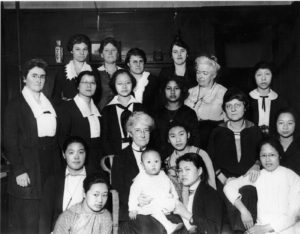Disrupting the Business of Human Trafficking – Then and Now
In 1874, a group of women opened a “safe house” on the edge of San Francisco’s Chinatown. Because their work disrupted the thriving trade in women between China and America, they faced endless legal challenges and even sticks of dynamite placed on their doorstep. By offering a place for survivors of sex slavery and other forms of servitude to escape to and drawing public scrutiny to the crime, they threatened their century’s existing business model of human trafficking.
Today, activists are using digital tools to challenge the business of modern-day slavery. I was particularly struck by the story of Berkeley doctoral grad Rebecca Sorla Portnoff who has used her computer sleuthing skills to track down and catch sex-traffickers. Portnoff, who is 29, graduated from Cal in 2017 and since then, she’s been working for Thorn: Digital Defenders of Children, a group that uses technology to fight the sexual abuse of children.
There are some notable differences – and at least one surprising similarity – between some of the first organized efforts to disrupt trafficking, which took place in the latter half of the nineteenth century and the early decades of the twentieth, and Portnoff’s twenty-first century work. Those pioneers in San Francisco wore tightly-corseted dresses and elaborate piles of hair. Few had college degrees (women were first admitted to U.C. Berkeley in 1871, and far later to most Ivy League schools.) Many professions were closed to women and they did not have the right to vote.
Portnoff, by contrast, knew by the end of her freshman year at Princeton that she wanted to follow her father into computer science. And while most students in her field were men, she wasn’t the only woman as she earned her doctorate degree from Cal. She wears her dark hair in a bun or tied back in a pony-tail, usually wears jeans and a t-shirt to work, and was inspired to work for a non-profit by the book HALF THE WORLD: Turning Oppression into Opportunity for Women Worldwide, by Nicholas Kristoff and Sheryl WuDunn. “I was moved and inspired by the efforts women made to improve their lives,” she told me, and Portnoff decided to help.
While the Victorian-era activists were known to climb ladders, scramble across rooftops, and barge into brothels to help vulnerable women in children, Portnoff creates computer codes that spot or identify similarities in traffickers’ online ads and to hunt down the Bitcoin accounts used to pay for the advertisements. She works on a laptop, often tracking down traffickers who are operating hundred or thousands of miles away.
I was fascinated by this video produced by UC Berkeley of Portnoff’s work. She hasn’t faced the sort of threats that the women of Chinatown’s Presbyterian Mission Home experienced, but, notably, comments have been disabled from the recent video posted of her work, since trolling is one of the hazards that Portnoff and others in her field face. She faces off other kinds of threats through teamwork. “This is not something any single person can do by sweeping in and saving the day,” she says. “I have a team to watch my back.”
There is another clear similarity between then and now: both instances are examples of women helping other women to find their freedom, deploying teamwork, organization, and grit. Both the 19th century anti-trafficking pioneers and Portnoff were inspired by their religious faith.
“I’m a Christian, and my choice to work in this space is directly derived from my understanding of the core tenets of the Christian faith: to love God, and to love my neighbor,” Portnoff explained to me. “In this modern era, my neighbor can be both my physical neighbor next door, or the child a thousand miles away that I will never meet.”
While technology has changed (and, thankfully, women can exercise the right to vote and most, thankfully, no longer wear bustles) the compassionate spirit that infuses Portnoff is similar to that which inspired her anti-trafficking sisters many years ago. #antitrafficking #womensempowerment #womenshistory
Julia Flynn Siler is the author of The White Devil’s Daughters: The Women Who Fought Trafficking in San Francisco’s Chinatown, which is forthcoming from Alfred A. Knopf in May. www.juliaflynnsiler.com.

Donaldina Cameron (center, with toddler on lap) surrounded by Mission Home workers, who were early anti-trafficking activists. Courtesy of Cameron House.
Dear Julia,
I just saw the article in Marin Magazine and am looking forward to reading your book. You probably know Cameron House, at the address you mention, is another of the results of Donaldina Cameron’s work. It has been providing services for almost 150 years. I let Board Members know about your book and jointing me at your upcoming event at Book Passages. http://www.cameronhouse.org. We are helping them hire a new Executive Director.
Thank you, Jacqueline! I worked closely with former Cameron House executive director Doreen Der-McLeod in researching this book, which centers on the home at 920 Sacramento Street. Good luck with your search and hope to see you at the Book Passage event on May 16th. Doreen and I will be in conversation at the Mechanic’s Institute at 6:30 p.m. June 12th: https://www.milibrary.org/events/white-devils-daughters-women-who-fought-slavery-san-franciscos-chinatown-author-julia-flynn